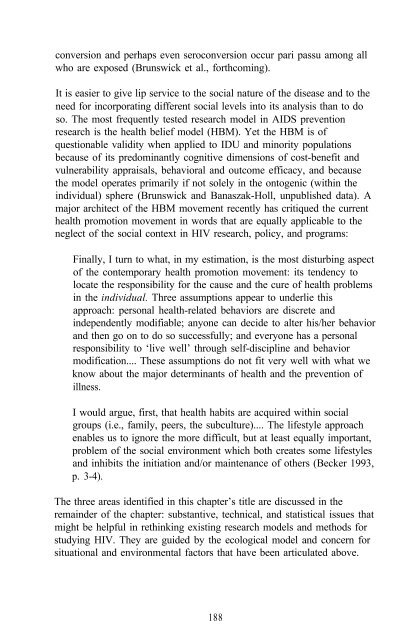The Context of HIV Risk Among Drug Users and Their Sexual Partners
The Context of HIV Risk Among Drug Users and Their Sexual Partners
The Context of HIV Risk Among Drug Users and Their Sexual Partners
You also want an ePaper? Increase the reach of your titles
YUMPU automatically turns print PDFs into web optimized ePapers that Google loves.
conversion <strong>and</strong> perhaps even seroconversion occur pari passu among all<br />
who are exposed (Brunswick et al., forthcoming).<br />
It is easier to give lip service to the social nature <strong>of</strong> the disease <strong>and</strong> to the<br />
need for incorporating different social levels into its analysis than to do<br />
so. <strong>The</strong> most frequently tested research model in AIDS prevention<br />
research is the health belief model (HBM). Yet the HBM is <strong>of</strong><br />
questionable validity when applied to IDU <strong>and</strong> minority populations<br />
because <strong>of</strong> its predominantly cognitive dimensions <strong>of</strong> cost-benefit <strong>and</strong><br />
vulnerability appraisals, behavioral <strong>and</strong> outcome efficacy, <strong>and</strong> because<br />
the model operates primarily if not solely in the ontogenic (within the<br />
individual) sphere (Brunswick <strong>and</strong> Banaszak-Holl, unpublished data). A<br />
major architect <strong>of</strong> the HBM movement recently has critiqued the current<br />
health promotion movement in words that are equally applicable to the<br />
neglect <strong>of</strong> the social context in <strong>HIV</strong> research, policy, <strong>and</strong> programs:<br />
Finally, I turn to what, in my estimation, is the most disturbing aspect<br />
<strong>of</strong> the contemporary health promotion movement: its tendency to<br />
locate the responsibility for the cause <strong>and</strong> the cure <strong>of</strong> health problems<br />
in the individual. Three assumptions appear to underlie this<br />
approach: personal health-related behaviors are discrete <strong>and</strong><br />
independently modifiable; anyone can decide to alter his/her behavior<br />
<strong>and</strong> then go on to do so successfully; <strong>and</strong> everyone has a personal<br />
responsibility to ‘live well’ through self-discipline <strong>and</strong> behavior<br />
modification.... <strong>The</strong>se assumptions do not fit very well with what we<br />
know about the major determinants <strong>of</strong> health <strong>and</strong> the prevention <strong>of</strong><br />
illness.<br />
I would argue, first, that health habits are acquired within social<br />
groups (i.e., family, peers, the subculture).... <strong>The</strong> lifestyle approach<br />
enables us to ignore the more difficult, but at least equally important,<br />
problem <strong>of</strong> the social environment which both creates some lifestyles<br />
<strong>and</strong> inhibits the initiation <strong>and</strong>/or maintenance <strong>of</strong> others (Becker 1993,<br />
p. 3-4).<br />
<strong>The</strong> three areas identified in this chapter’s title are discussed in the<br />
remainder <strong>of</strong> the chapter: substantive, technical, <strong>and</strong> statistical issues that<br />
might be helpful in rethinking existing research models <strong>and</strong> methods for<br />
studying <strong>HIV</strong>. <strong>The</strong>y are guided by the ecological model <strong>and</strong> concern for<br />
situational <strong>and</strong> environmental factors that have been articulated above.<br />
188
















